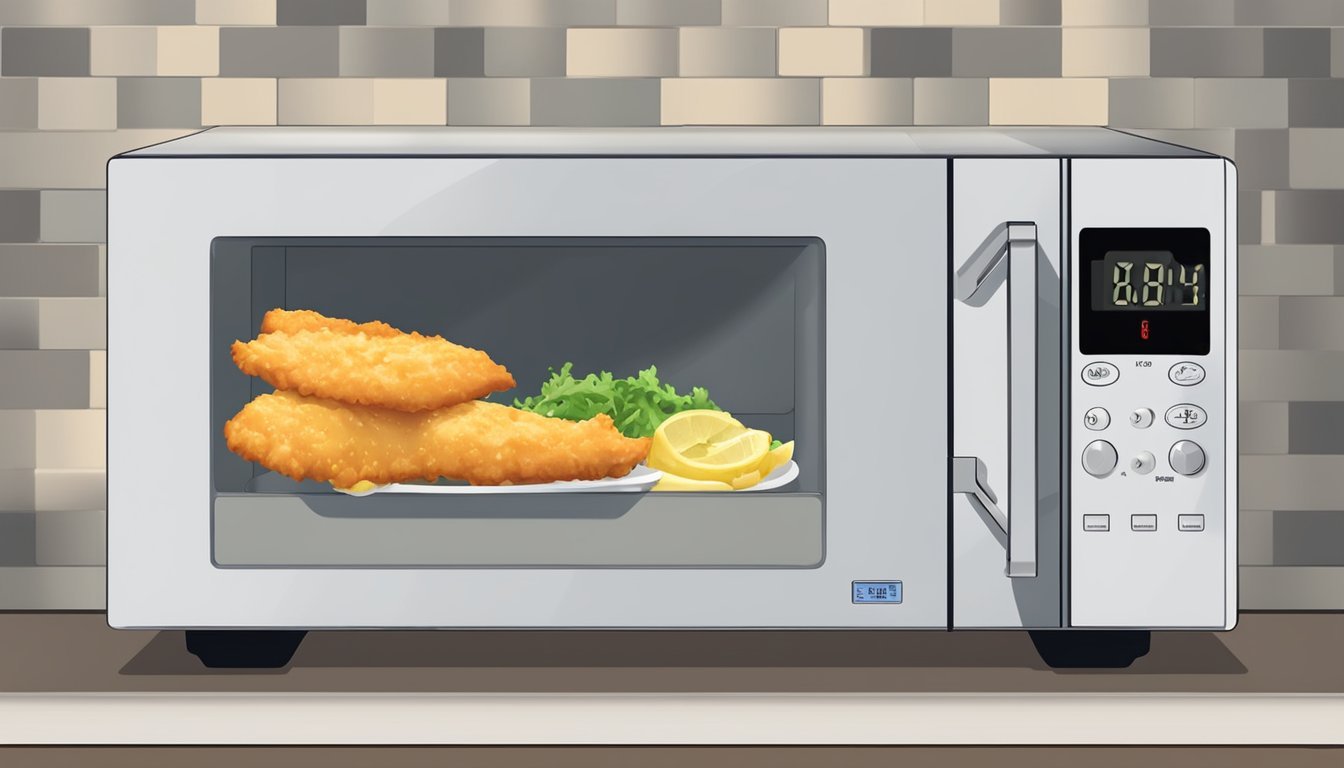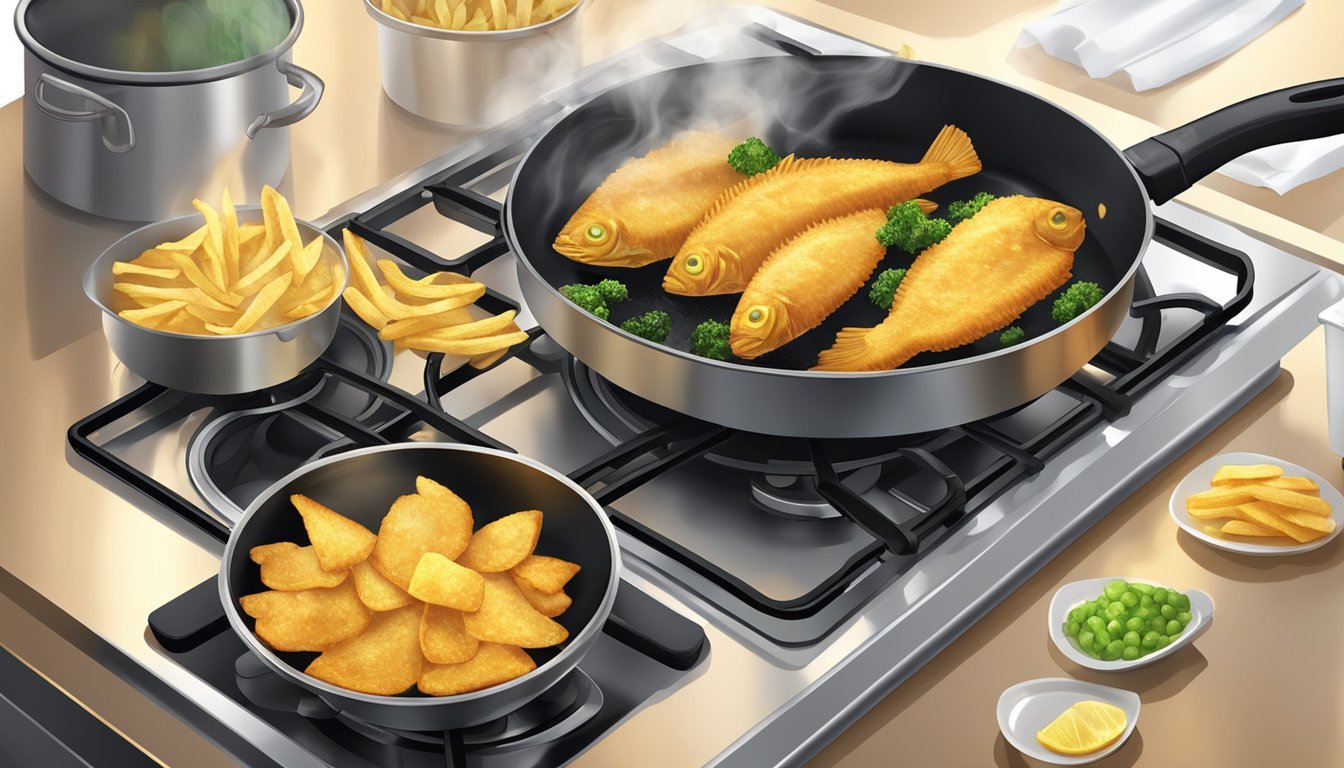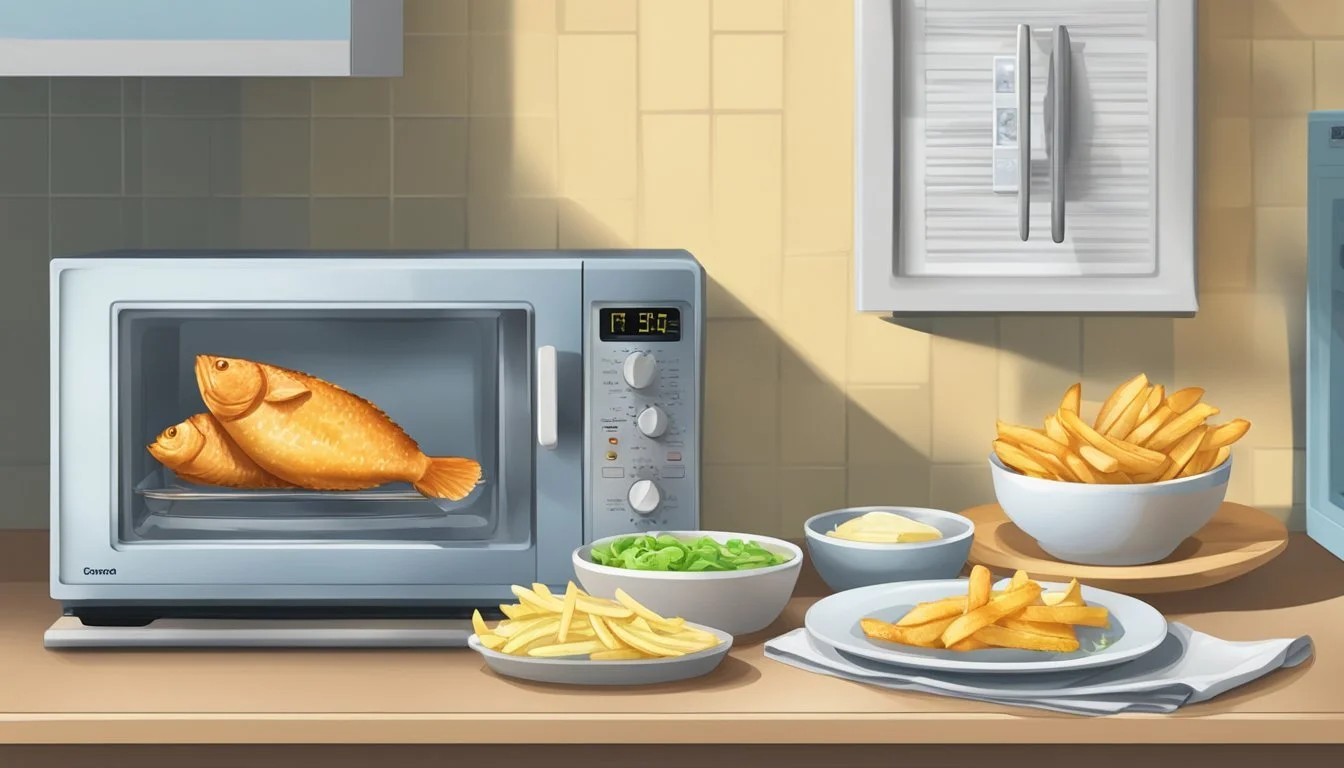How to Reheat Fish and Chips for Maximum Freshness
Nothing beats the satisfying crispiness of freshly cooked fish and chips, but figuring out how to reheat them without losing their crunch can be tricky. Many people struggle with soggy or unevenly heated leftovers, but with a few simple methods, you can enjoy your favorite dish just as much the second time around. Using an air fryer, an oven, or a stovetop can help you achieve that perfect balance of crispy and juicy results.
Reheating fish and chips may seem daunting, yet it's straightforward with the right approach. For those with an air fryer, set it to 320°F and reheat the fish for 4 minutes, flip, and cook for another 3 minutes. For the chips, increase the temperature to 360°F and reheat for 5 minutes. This method maintains the desired crunch and texture.
For oven aficionados, preheating to 350°F and lining a baking tray with greaseproof paper can be useful. Place the fish and chips separately on the tray, cover with tin foil to prevent burning, and reheat. The stove method offers another alternative, using a skillet to keep the fish crispy while ensuring the chips remain tender inside. With these techniques, perfectly reheated fish and chips are within reach, ready to be enjoyed once more.
Fundamentals of Reheating Fish and Chips
Reheating fish and chips requires a blend of proper technique and careful selection of methods to maintain their texture and taste. This guide will walk through the basics and how to choose the right reheating method.
Understanding Reheat Basics
The primary goal when reheating fish and chips is to ensure the fish remains moist and flaky inside, while the exterior retains its crunch. It's crucial to start with food that is safe to reheat; this means it should have been stored properly in a refrigerator, not left out for long periods.
Using a food thermometer ensures that the internal temperature of the food reaches at least 165°F for safe consumption. Avoid overcrowding the fish and chips during reheating, as this can lead to uneven heating and sogginess.
Selecting the Right Reheat Method
Different methods for reheating fish and chips include the oven, air fryer, and microwave. Each method has its pros and cons.
Oven Reheating
Preheat: Set the oven to 350°F.
Preparation: Place fish and chips on a baking tray lined with parchment paper.
Heat: Bake for 15-20 minutes, flipping halfway.
Air Fryer
Temperature: Set to 320°F.
Duration: Fry fish for 4 minutes, flip, then fry for 3 more minutes.
Chips: Increase to 360°F and fry for 5 minutes.
Microwave
Preparation: Pat food with paper towels.
Setting: Use the low heat setting.
Time: Reheat for around 3 minutes.
Choosing the right method depends on the tools available and the desired outcome. Ovens and air fryers are preferred for maintaining crispiness, while microwaves can be quick but might result in sogginess.
Preparation for Reheating
Proper preparation is crucial to ensure your leftover fish and chips remain crispy and delicious. Follow these key steps to store and reheat them effectively.
Storing Leftover Fish and Chips
Leftover fish and chips should be stored immediately after your meal to maintain their quality. Place the leftovers in an airtight container to prevent moisture from making the batter soggy.
Refrigerate the container if you plan to eat the leftovers within 1-2 days. For longer storage, place the container in the freezer, which can preserve the fish and chips for up to a month. Label the container with the date to keep track of its freshness.
Preheating Your Appliance
Before reheating, preheat your appliance to ensure even warming and crispiness. If using an air fryer, set it between 320-370°F based on your preferred method.
For oven reheating, preheat it to approximately 350°F. Preheating helps the fish and chips reheat evenly without drying out. Arrange the fish and chips in a single layer to avoid overcrowding, which can lead to uneven heating and loss of crunchiness.
By storing leftovers correctly and preheating your appliances, your reheated fish and chips will taste almost as good as when they were first prepared.
Reheating in the Oven
Reheating fish and chips in the oven is a method that ensures they retain their crunchiness and flavor. This approach uses even heat distribution, making it a preferred option for many.
Oven Method Overview
The oven method requires a conventional or convection oven set to a certain temperature. The process involves prepping the fish and chips, placing them on a baking sheet, and using aluminum foil or parchment paper to prevent burning.
What You Need:
Oven
Baking sheet
Aluminum foil or parchment paper
Step-by-Step Oven Reheating
Preheat the Oven
Set your oven to 375°F (190°C). This temperature helps heat the fish and chips evenly without drying them out.Prepare the Baking Sheet
Line a baking sheet with parchment paper or aluminum foil. This prevents sticking and makes cleanup easier.Arrange the Fish and Chips
Place the fish and chips on the baking sheet. Ensure they are spread out in a single layer to allow even heating. Avoid overlapping them to maintain their crisp texture.Cover with Foil
Lightly cover the fish and chips with aluminum foil. This helps to retain moisture and prevents burning.Reheat in the Oven
Bake for 10-15 minutes. Check after 10 minutes to see if they are hot and crispy. If not, continue heating, checking every 2 minutes.
Using these steps, reheating fish and chips in the oven is straightforward and effective. This method restores their original quality with minimal fuss.
Reheating on the Stovetop
Reheating fish and chips on the stovetop is convenient and effective. Key methods involve using a skillet or frying pan to restore crispness without making the components soggy.
Using a Skillet
A skillet, especially a non-stick one, can bring back the crunch to fish and chips effectively.
Preparation: Remove the leftover fish and chips from the refrigerator. Lightly pat them with a paper towel to remove excess moisture.
Heating: Place a non-stick skillet on the stove and set it to medium heat.
Oiling: Add a small amount of vegetable oil to the skillet. Allow the oil to heat up until it shimmers but does not smoke.
Reheating Fish: Place the fish in the skillet. Heat for 2-3 minutes per side, ensuring an even, crispy texture.
Reheating Chips: After removing the fish, arrange the chips in a single layer in the same skillet. Toss them gently in the oil and heat for another few minutes until they regain their crispness.
Frying Pan Techniques
Using a frying pan ensures your fish and chips are reheated with the right texture.
Preparation: Take the leftover fish and chips out of the refrigerator and pat them dry with a paper towel to reduce moisture.
Heating: Place a frying pan on your stove and set it to medium heat.
Oiling: Pour a small amount of vegetable oil into the pan, then heat until slightly shimmering.
Reheating Fish: Once the oil is hot, place the fish in the pan. Let it heat for 3-4 minutes on each side, turning until golden and crispy.
Reheating Chips: Remove the fish, then add the chips in a single layer. Fry for several minutes, tossing occasionally to ensure they heat evenly and stay crisp.
These steps ensure that your reheated fish and chips are crispy and delicious.
Reheating in the Microwave
Reheating fish and chips in the microwave can be efficient if done properly. Attention to microwave-safe practices and techniques to avoid sogginess is essential.
Microwave-Safe Practices
Use a microwave-safe dish to prevent any potential hazards. Place the fish and chips on the dish, ensuring they are spread out for even heating.
Before reheating, allow the food to reach room temperature. This minimizes uneven heating. Cover the dish with a paper towel to absorb excess moisture.
Set the microwave to a low heat setting or the reheat function if available. Start with intervals of 2-3 minutes for the fish, checking after each interval.
Pro tip: Flip the food or give the plate a gentle shake to ensure even warming throughout.
Avoiding Sogginess in Microwave Reheating
To maintain the crunchiness of the fish and chips, special steps are necessary. Use a paper towel to pat the fish and chips dry before placing them in the microwave.
Cover the dish with another paper towel during reheating to further absorb moisture. Reheat in short intervals to prevent overheating, which can make the food soggy.
After the initial reheating, if parts are not warm enough, continue with 30-second increments until the desired temperature is reached. Avoid overheating as this can make the food less crispy.
By following these steps, fish and chips can be effectively reheated in the microwave, preserving as much of the original texture and flavor as possible.
Reheating Using an Air Fryer
Reheating fish and chips in an air fryer can restore their original crispiness and flavor. The process involves preheating the air fryer, arranging the food properly, and following specific time and temperature settings.
Air Fryer Method Explanation
The air fryer is an excellent tool for reheating fish and chips because it uses hot air circulation to mimic the crisping effect of deep frying. This circulation ensures even heating, which is essential for retaining the original texture of the food.
The air fryer basket should not be overcrowded, as this allows hot air to circulate freely around each piece. A light spray of oil can also help enhance the crispiness of the fish and chips.
Air Fryer Reheating Steps
Preheat the Air Fryer: Set the air fryer to 375°F (190°C) and let it preheat for 3-5 minutes.
Arrange Food in Basket: Place the leftover fish and chips in a single layer inside the air fryer basket. Avoid overlapping or overcrowding to ensure even reheating.
Initial Cooking Time: Cook for 5-8 minutes. During this time, flip the fish and shake the basket halfway through the cooking process.
Adjust and Finish Cooking: If needed, increase the temperature to 370°F (190°C) and cook for an additional 2-3 minutes to enhance crispiness.
By following these steps, the fish and chips should return to a state that closely resembles their freshly cooked state.
Additional Tips and Tricks
Achieving the perfect reheated fish and chips involves maintaining crispiness and proper moisture levels. Below are key strategies to help achieve these goals.
Achieving Crispy Results
To keep fish and chips crispy, use an air fryer or convection oven. These methods circulate hot air around the food. Place the fish on a wire rack to allow air to flow underneath, preventing soggy bottoms.
Reheat fish and chips separately. Fish should be heated at a lower temperature to avoid drying out. Preheat the oven to around 320°F (160°C) for the fish. Reheat for about 7-10 minutes, flipping halfway. For chips, preheat to 360°F (180°C) and reheat for about 5-6 minutes until they regain their crunch.
Position chips evenly on the tray and avoid overcrowding. Overlapping chips can hinder even heating, reducing crispiness. Use a light spray of oil to help retain a crunchy texture.
Moisture Control
Maintaining the right moisture level is crucial to avoid a dry texture. Wrap fish in aluminum foil lightly to contain moisture. Ensure the wrap isn’t too tight, allowing steam to escape, preventing condensation buildup. For microwaving, place a damp paper towel over chips to keep them from drying out.
Remove any excess oil before reheating by lightly dabbing with a paper towel. This can prevent the fish from becoming overly greasy. Avoid placing reheated food directly on solid surfaces; instead, use a wire rack to let moisture escape.
Give ample space around each item when reheating. Crowding can lead to steam pockets, making the food lose its desired texture. Rest heated items for a few minutes before serving to allow residual heat to spread evenly without creating excessive moisture.
Safety and Best Practices
When it comes to reheating fish and chips, adherence to safety guidelines is crucial.
To ensure safety, always verify the food has been stored correctly. Refrain from reheating if it's been left out for more than two hours.
Temperature is key. Always reheat fish to at least 165°F (74°C) to kill any potential bacteria. Using a food thermometer can help ensure accuracy.
Avoid using the microwave for reheating fish and chips. The microwave often fails to heat food evenly, which may leave cold spots where bacteria can thrive.
Best practices suggest using the oven or an air fryer. Arrange fish and chips in a single layer to promote even heating. Preheat the oven or air fryer to the recommended temperature before placing the food inside.
When flipping the food, use clean utensils to avoid cross-contamination. Always place chips and fish on clean, non-contaminated surfaces.
Pro Tip: Lightly misting fish and chips with a bit of oil can help retain their crunchiness during reheating.
Pairing Suggestions
Pairing the right accompaniments with reheated fish and chips can elevate the meal. Here are some delightful options to consider.
Mushy Peas: This classic British side dish complements fish and chips perfectly. The creamy texture of mushy peas contrasts well with the crunchiness of the reheated fish and chips.
A sprinkle of malt vinegar over the fish and chips enhances their flavor profile. The sharp, tangy vinegar cuts through the richness of the fried fish, balancing the taste.
Tartar Sauce: A dollop of tartar sauce adds a creamy, tangy touch. It pairs wonderfully with the fish, adding a zesty flavor.
For a healthier option, consider a side salad. A light, crisp salad with a simple lemon vinaigrette can provide a refreshing contrast.
Pickled Onions: These add a tangy crunch to the meal, providing a burst of flavor that complements the fish and chips.
A light beverage such as a crisp lager or a sparkling water can cleanse the palate between bites, enhancing the dining experience.
Side Dish Benefits Mushy Peas Creamy texture, classic pairing Malt Vinegar Sharp, tangy flavor cuts through richness Tartar Sauce Creamy, tangy addition Side Salad Refreshing, light contrast Pickled Onions Tangy, crunchy addition Light Beverage Palate cleanser
By thoughtfully selecting these accompaniments, one can enjoy reheated fish and chips to their fullest potential.
Long-Term Storage and Final Considerations
Properly storing fish and chips can significantly extend their shelf life. Whether freezing or refrigerating, it’s essential to maintain flavor and texture while following safety guidelines.
How to Freeze Fish and Chips
To freeze fish and chips, start by allowing them to cool to room temperature. This prevents condensation, which can lead to freezer burn. Wrap each piece of fish and portions of chips in aluminum foil. Then, place the wrapped items in a single layer in a freezer-safe bag or container. Ensure it is airtight to prevent moisture loss.
Label the bags with the date to keep track of their freezing duration. Fish and chips typically last up to 3 months in the freezer. Before reheating, let them thaw in the refrigerator for several hours or overnight. This gradual thawing helps maintain texture and flavor.
FAQs on Freezing and Reheating
How long do fish and chips last in the fridge?
Fish and chips can be stored in the fridge for up to 2 days. Ensure they are placed in an airtight container to keep them fresh.
Can you reheat fish and chips from the chip shop?
Yes, you can. The best method is to reheat in the oven at 375°F (190°C) until hot and crispy. Avoid using a microwave as it can make them soggy.
Can I freeze leftovers?
Absolutely. Follow the steps outlined in the freezing section. Make sure leftovers have cooled thoroughly before freezing.
How should I reheat frozen fish and chips?
Preheat your oven to 375°F (190°C). Remove the fish and chips from their wrapping and place them on a baking sheet. Heat for about 15-20 minutes or until thoroughly hot and crispy.
By following these methods, you can enjoy your fish and chips just as crispy and flavorful as when they were freshly made.




